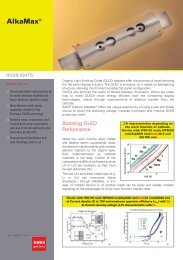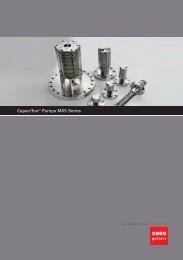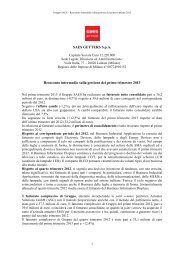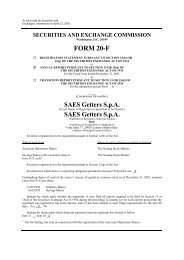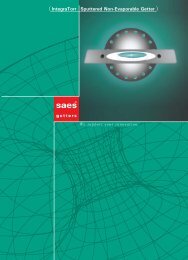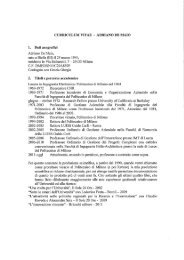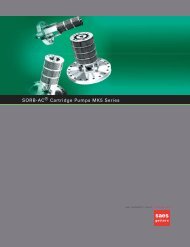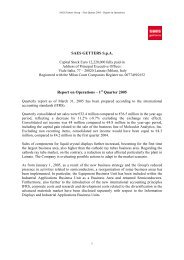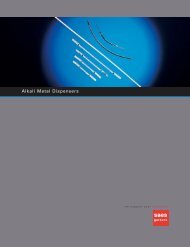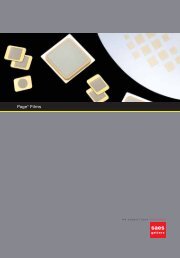CapaciTorr MK5 Series_general__0.pdf - SAES Getters
CapaciTorr MK5 Series_general__0.pdf - SAES Getters
CapaciTorr MK5 Series_general__0.pdf - SAES Getters
You also want an ePaper? Increase the reach of your titles
YUMPU automatically turns print PDFs into web optimized ePapers that Google loves.
<strong>CapaciTorr</strong> Pumps - <strong>MK5</strong> <strong>Series</strong>GENERAL INFORMATION<strong>CapaciTorr</strong> Pumps, a type of vacuum pump manufactured by Saes <strong>Getters</strong> S.p.A., sorb active gaseswith a nonevaporable getter (NEG) material. They are used alone or in combination with other vacuumpumps in several applications in the high and ultrahigh vacuum field (HV and UHV).WORKING PRINCIPLESThe pumping process sorbs by chemical reaction active gas molecules impinging on the cleanmetal surface of each particle of getter material contained in the pump cartridge. A clean metal surfacemeans a metal surface not covered by oxide or carbide layers which result when the getter materialis exposed to air during manufacturing, installation or air venting steps.The method used to obtain this clean metal surface distinguishes the nonevaporable getter pumpsfrom others:The getter material does not need to be evaporated, as does titanium in a titanium sublimation pump.It only needs to be heated, under dynamic vacuum, to diffuse the passivation layer covering thesurface of each getter particle into the bulk of the getter material. The passivation layer consists mainlyof oxides and carbides. This heat treatment, called activation, enhances the kinetics of this diffusionprocess, kinetics which are negligible at room temperature.In this way the getter material maintains its original configuration of metal particles sintered togetherto form a porous body. The activation process is illustrated schematically in figure 1, in which a singlegetter particle is considered.H 2OH 2 OpassivatinglayerH 2InactiveNEGparticleH 2O 2N 2 COHEATVacuumorInert GasActiveNEGparticleO 2CON 2Figure 1Once activated, the sorption process or pumping action of a <strong>CapaciTorr</strong> Pump can be split into threemain steps. The first step is the dissociation of the gas molecule, which occurs on the surface. Thesecond step, surface sorption, always occurs for any type of active gas. The third step is bulk diffusionwhich may or may not occur according to the specific working temperature and gas.When bulk diffusion does not take place, the successive sorption of the gas molecules progressivelysaturates the surface of the getter material until sorption ceases. To restore the sorption process, itis necessary to remove this passivation layer by heating and diffusing the gas molecules sorbed ontothe surface into the bulk of the getter material. This process is called reactivation.During the life of the device, depending on the operating temperature of the pump, successivereactivations of the cartridge are possible to restore pumping performance until the full cartridgecapacity has been reached.GETTER MATERIALSThe getter materials used in the <strong>CapaciTorr</strong> pumps <strong>MK5</strong> series are a Zr-V-Fe material with the tradename St172 (a mixture of Zr powder and St 707 getter alloy), and a Ti-V material with the trade nameof St 185.We support your innovation1
These getter materials, originally in powder form, are consolidated to form the getter elements of thegetter pump, which can be either disks or blades, through a process of mild compression followedby a controlled sintering step. This manufacturing procedure results in very good mechanicalcharacteristics and very high porosity, which results in higher sorption performances.St 172-based <strong>CapaciTorr</strong> pumps are ideal for best performances in terms of speed and they areparticularly well suited for high gas load applications where it is necessary to increase the pumpoperating temperature to boost the material sorption capacity.The St 185 based <strong>CapaciTorr</strong> pumps are ideal when best mechanical performances are requested.These alloys pump all the active gases and are especially efficient in pumping hydrogen and itsisotopes. The active gases (CO, O 2 , N 2 ) are permanently sorbed by these getter alloys, while hydrogenand its isotopes can be removed from the alloys in accordance with Sieverts' Law.PUMPING CHARACTERISTICSBehavior of the getter materialsIt is possible to identify four main families of gases with respect to their interaction with the gettermaterials. The first family consists of hydrogen and its isotopes, which are sorbed reversibly. Thesecond family consists of other actives gases such as CO, CO 2 O 2 and N 2 which are sorbed irreversibly.The third family consists of gases, which are sorbed, in a combination of the two above describedways such as water and hydrocarbons. The fourth family consists of rare gases, which are not sorbedby the getter material.HydrogenHydrogen does not form a stable combination with the getter alloy but diffuses rapidly into the bulkof the active material, where it is stored as a solid solution. A given concentration of hydrogen insidethe getter alloy corresponds to an equilibrium pressure of hydrogen which is strongly dependent ontemperature. This dependence is described by Sieverts' Law given by the following expression:Log P = A +2 Log q - B TWhere:q = is the concentration, in liter•Torr/gram of alloyP = is the equilibrium pressure, in TorrT = is the getter temperature, in KA and B are experimentally determined constants that depends on the getter material type.For St172 A =4.45 and B =5730For St185 A =4.536 and B =5719<strong>CapaciTorr</strong> pumps can be used as heat controlled reversible pumps, which pump hydrogen at lowtemperature and release it at high temperature.The equilibrium curves for St 172 and St 185 are reported in Fig. 2 and Fig. 3.We support your innovationHydrogen Equilibrium Pressure (Torr)10 -110 -210 -310 -410 -510 -610 -7Hydrogen Equilibrium Pressureon St172 ® Alloy450°C400°C350°C300°C500°C550°C600°C650°C700°CHydrogen Equilibrium Pressure (Torr)10 -110 -210 -310 -410 -510 -610 -7Hydrogen Equilibrium Pressureon St185 AlloyFigure 2 Figure 310 -810 -2 10 -1 10 0 10 1 10 2Hydrogen Concentration (Torr•l/g)2450°C400°C350°C300°C550°C500°C600°C650°C10 -810 -2 10 -1 10 0 10 1 10 2700°CHydrogen Concentration (Torr•l/g)
Other Active GasesOther active gases such as carbon monoxide, carbon dioxide, nitrogen and oxygen are chemisorbedirreversibly by the getter material. The chemical bonds of the gas molecule are first broken on thesurface of the getter and then the various constituents are sorbed as atoms, forming oxides, carbidesand nitrides. The strength of the chemical bonds between the getter and these elements is so strongthat even if the getter material is heated to temperatures of the order of 1000°C, no gases are releasedinto the vacuum environment. On the contrary, high temperature treatments promote the diffusionof the gas species into the bulk of the getter material, cleaning the surface for further sorption.Water Vapor and HydrocarbonsWater vapor and hydrocarbon chemical bonds are cracked on the surface of the getter material.Hydrogen, oxygen and carbon are then sorbed as explained above. However, sorption efficiency ofhydrocarbons at temperatures under 500°C is very low.Rare GasesRare gases are not sorbed by the getter materials. <strong>CapaciTorr</strong> pumps can be therefore used to removeimpurities of active gases in rare gas filled devices.Pumping PerformancesDue to the working principle of the getter material and its typical behavior toward different gas families,the pumping performance (pumping speed and gettering capacity) of <strong>CapaciTorr</strong> pumps depends onthe type of gas sorbed and the operating conditions (temperature) of the getter cartridge.The pumping performance of <strong>CapaciTorr</strong> pumps is measured according to the ASTM standard F798-82, which specifically refers to nonevaporable getter devices. The procedure is an application of thewell-known dynamic flow method, also used for measurements in other standards. The test is carriedout at constant pressure over the getter device. It is important to notice that the testing pressure doesnot affect the pumping speed of the pump when the pressure is below 10 -5 Torr.10000Pumping Speed (I/s)1000H 2 - 25°CH 2 O - 280°CH 2 - 280°CCO - 280°C100H 2 O - 25°CCO - 25°C100.01 0.1 1 10 100 1000Figure 4Sorbed Quantity (Torr•l)Typical pumping speed curves of a generic NEG pumpIn fig. 4, the typical pumping speed curves of a <strong>general</strong> getter pump for H 2 , CO and H 2 O are shown.The pumping speed value is plotted versus the quantity of gas sorbed during the test. As mentionedabove, it would be meaningless and misleading to plot it versus the pressure as in sputter ion pumps.The different sorption mechanisms of the getter material towards H 2 (high diffusion rate both at highand room temperature) and CO (low diffusion rate at room temperature, high diffusion rate at hightemperature) are also evident in the curves.The effect of the diffusion phenomena for the sorption of CO is interesting to note. When diffusionis not present, i.e. operating at room temperature, only the surface of the getter is available for thesorption of the gas. Therefore the capacity is limited and the pumping speed drops to low valueswhen the surface becomes saturated. In this case, many reactivations will be necessary to use thetotal capacity of the getter cartridge. When diffusion is present, i.e. (operating at high temperature),the bulk of the getter material is available for gas sorption. The capacity for a single activation processis much larger and an almost constant value of the pumping speed is maintained for a much longertime.We support your innovation3
There is not a big difference in sorption performance of H 2 , which diffuses quickly into the bulk of thegetter material, even at room temperature.Oxygen and nitrogen in the bulk diffusion regime are sorbed with pumping speeds of approximately:65% for O 2 and 15% for N 2 with respect to that of H 2 .Hydrocarbons are sorbed only at elevated temperatures and with very low efficiency.Activation of a <strong>CapaciTorr</strong> pumpAs previously mentioned the non-evaporable getter materials used in the <strong>CapaciTorr</strong> pumps developtheir pumping characteristics after an activation process, i.e. after heating them to a suitable hightemperature under dynamic vacuum for an appropriate time.The heat treatment diffuses the thin protective layer, formed on the surface of the getter particles byair exposure during manufacture, into the bulk and makes the surface of the getter material clean andable to sorb the gas molecules of the vacuum system in which it is operated.The efficiency of this activation process is related to the diffusion coefficient of the specific gettermaterial, which in turn depends on an exponential function of the temperature. It is also related tothe square root of time, as all the diffusion processes.The standard activation conditions for the <strong>CapaciTorr</strong> pump that uses St 172 getter material is set at450 °C for 45 minutes and for the pumps that use St 185 Getter material at 500 °C for 45 minutes.These conditions can be modified considering that lower temperatures should be compensated bylonger times and vice versa. The activation process should be carried out after a pump down of thevacuum system to a pressure of 10 -4 Torr or less. After having reached this pressure range the heatercan be energized to reach the desired temperature.During the heating phase, gases desorb from the getter cartridge. This is due to the physisorbed gaseswhich form the external monolayers covering the surface of the getter material, while chemisorbedlayers are diffused into the bulk of the getter material.Desorbed gases include H 2 O, CO, CO 2 , CH 4 , and eventually H 2 , due to the behavior of the getter materialtoward this gas. In order to minimize this gas evolution, baking the system, with the getter cartridgemaintained at a relatively higher temperature than the other components of the system has beenfound to be effective. This procedure minimizes the migration of the gases desorbed from the wallof the system toward the getter cartridge, which has a real surface area much larger than the systemwalls themselves.During the activation it is advisable not to exceed pressures in the 10 -3 Torr range to avoid phenomenaof corrosion of the heater wire, RF discharges between the heater and other pump elements andcontamination of the gettering material due to excessive sorption of active gases during the activationprocess.For this purpose and depending on the backing pump pumping speed, it may be advisable to activatethe getter cartridge by successive steps, not applying the full power to the heater at the beginningof the activation process. In this case, reaching the activation temperature may take a few hours,compared to the 30 minutes usually needed if full power is applied at the beginning.Operation of <strong>CapaciTorr</strong> pumpsWhen activated, the <strong>CapaciTorr</strong> pumps can be operated at various temperatures according to the loadof active gases, taking into consideration two main facts. Firstly, the higher the temperature, the higherthe diffusivity of the sorbed gases into the bulk of the getter material. Secondly, the higher thetemperature, the higher the H 2 equilibrium pressure. High temperature operation is preferred whenhigh gas loads are present. In this way it is possible to maintain a high diffusion rate and consequentlya constant pumping speed for all the active gases. Temperatures in the range of 250 – 350 °C aretypically suggested for St 185 based cartridges. Temperatures in the range of 150 – 250 °C are typicallysuggested for St 172 based cartridges. High temperature is usually not compatible with UHV operationdue to desorption of hydrogen from the getter material.We support your innovation4
Room temperature operation is indicated when the gas load is low and when it is mandatory tomaintain the operating pressure below 10 -8 Torr. When pumping high purity hydrogen, operating atroom temperature is also possible with high gas loads, due to the high diffusivity of H 2 at thattemperature. In this latter case, a careful evaluation of the gas load and the quantity of gas sorbedare necessary to avoid possible embrittlement.Reactivation of <strong>CapaciTorr</strong> PumpsThe reactivation of the getter cartridge of a <strong>CapaciTorr</strong> Pump is necessary when the cartridge isexposed to air or when its pumping speed falls below acceptable limits. In both cases the surfaceof the getter material becomes covered by a passivation layer of mainly carbides and oxides. Ifreactivation is preceded by an air exposure and a successive pump down cycle, it should follow thesame procedure and has the same characteristic of the first activation. If the reactivation followsnormal in vacuum operation without air venting, it may be shorter and carried out at a lower temperature(indicatively 25% lower). Moreover during a reactivation which follows normal in vacuum operationthe only gas released is hydrogen.Through successive reactivations it is possible to use the entire capacity of the getter material.When the pumping speed no longer recovers sufficiently after reactivation, the cartridge must replaced.Regeneration of SORB-AC Cartridge PumpsHydrogen and hydrogen isotopes sorbed by the cartridge can be released from the getter materialthrough a regeneration treatment.Regeneration is necessary when:••The pumping speed for hydrogen isotopes has fallen below acceptable limits because the equilibriumpressure has been approached.Equilibrium is far from being reached but the hydrogen or hydrogen isotopes quantity pumped isapproaching the embrittlement limit (20 Torr•l/g for St 172 and 30 Torr•l/g for St 185).Embrittlement of the material takes place when the quantity of hydrogen sorbed in the getter materialis high enough to modify its mechanical characteristics causing it to lose its mechanical integrity. Theprocess of hydrogen sorption and successive desorption (regeneration), can be visualized on theSieverts' plots of each specific alloy (see fig.5).The temperature increase of the getter alloy establishes a high hydrogen equilibrium pressure, allowinghydrogen removal by means of a standard backing pump. From the plot in fig. 5 one can see that theregeneration process will be more efficacious at higher temperature. The time necessary for theregeneration of a cartridge is given by the expression:t = M/F(1/q f – 1/q i )10 -(A-B/T)P (Torr)DesorptionT 2T 1▼▼Figure 5Sorptionq f q iT 1= sorption temperatureT 2= regeneration temperatureq (Torr•l/g)We support your innovation5
Where:t = is the regeneration timeM = is the mass of the getter material in gramsF = is the speed in l/s of the backing pumpq f = is the final quantity of H 2 in the getter material in Torr•l/gq i = is the initial quantity of H 2 in the getter material in Torr•l/gA and B are the Sieverts’ constants for the specific getter materialT = is the regeneration temperature in KDue to the exponential shape of the regeneration curve, a significant amount of time is saved whenthe regeneration is not programmed to be complete (100% of the sorbed hydrogen released again)but only partial (for example 90%). Thus if a given amount of hydrogen must be sorbed in each cycle(for instance 10 liter torr/g) it is much better to operate in the q f =2 q i = 12 mode than in the q f = 0q i = 10 mode.SPECIAL INSTRUCTIONSAir ventingOpening the vacuum chamber where <strong>CapaciTorr</strong> pumps are mounted should be performed only whenthe getter material is at room temperature or at least below 50°C for St 172 based cartridges and 150°C for St 185 based cartridges. After each air exposure, a new reactivation of the getter cartridge isrequired.A progressive reduction of pumping speed for hydrogen and active gases is observed after successiveexposures to air. Fig. 6 shows the reduction of pumping speed of a <strong>CapaciTorr</strong> B 1300-2 pump aftersuccessive air ventings. Similar behavior has been observed for St 172 based <strong>CapaciTorr</strong> pumps. Anactivation at higher temperatures can be effective in improving the recovery of the sorption performancesafter successive air ventings.1000<strong>CapaciTorr</strong> B 1300-2 <strong>MK5</strong>Pumping Speed (l/s)10010Test gas: COSorption temperature: 25 °CActivation: 500°C x 45'Sorption pressure: 3 •10 -6 TorrCycle 1Cycle 10Cycle 51Act.550°C x 45'Cycle 50Figure 610,001 0,01 0,1 1 1Sorbed Quantity (Torr•l)If dry nitrogen is used instead of air, the pumping speed reduction, after the same number of exposures,appears to be diminished. This is because, for the first cycles, the effect of the reactivation whichfollows a nitrogen exposure is greater than the new contamination caused by exposure to nitrogen.Further improvement is obtained when pure argon is used as a protective gas during maintenanceoperations.We support your innovation6
Vacuum failure during activation or regenerationDuring activation or regeneration of <strong>CapaciTorr</strong> cartridge pumps, air must not be allowed to suddenlyenter the vacuum system. Such an occurrence could cause burning, i.e. a quick oxidation, of the gettermaterial.This happens if the temperature of the cartridge at the moment of vacuum failure is above 100°C inthe case of St172 cartridges and above 300°C in the case of St 185 cartridges.The burning is slow and progressive, not explosive.Should a serious vacuum failure take place when the temperature of the cartridge is high althoughbelow the above indicated values, permanent damage of varying degrees will occur according totemperature, but not burning.In this case, pumping characteristics of the getter material would be affected to a greater or lesserextent depending on temperature and time. Also, in these cases, a more efficient recovery of getteringefficiency can obtained by using a reactivation procedure at a temperature higher than the normallyadopted value.Mechanical ShocksDue to the mechanical characteristics of the insulating elements of the heater (ceramic spacers)particular care must be observed in handling during assembly (and removal) of the pumping system.Accidental dropping and similar mechanical shocks could result in breakage of the insulating elementswith possible short circuits of the electrical path.We support your innovation7
E.VS.17.1The <strong>SAES</strong> <strong>Getters</strong> Group manufacturing companies are ISO9001 certified, the Asian and Italian companies are ISO14001certified also. Full information about our certifications for each company of the Group is available on our website at:www.saesgetters.com© 2001 <strong>SAES</strong> <strong>Getters</strong>. Printed in Italy. All rights reserved. <strong>SAES</strong> ® is registered trademark of <strong>SAES</strong> <strong>Getters</strong> S.p.A., its subsidiaries and affiliates.<strong>SAES</strong> <strong>Getters</strong> reserves the right to change or modify product specifications at any time without notice.<strong>SAES</strong> <strong>Getters</strong> Groupwww.saesgetters.comneg_technology@saes-group.com



